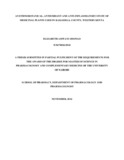| dc.contributor.author | Odongo, Elizabeth A | |
| dc.date.accessioned | 2017-01-11T08:24:26Z | |
| dc.date.available | 2017-01-11T08:24:26Z | |
| dc.date.issued | 2016 | |
| dc.identifier.uri | http://hdl.handle.net/11295/100283 | |
| dc.description.abstract | Background
For years, medicinal plants have been used worldwide for the treatment of various diseases.
Generally, they are considered safer, easily available and more cost effective compared to
conventional medicine. To date, medicinal plants still remain a promising source of natural
antioxidant and anti-inflammatory agents to address the increasing burden of diseases related to
oxidative damage and inflammation.
Objective
The aim of the present work was to screen medicinal plants commonly used in Kakamega
county, western Kenya for their antioxidant and anti-inflammatory activity.
Methodology
An ethnobotanical survey was undertaken to establish medicinal plants used to treat various
ailments in Kakamega County. Direct interviews were carried out using structured
questionnaires. Plant specimens were collected, identified and voucher specimens deposited at
the herbarium at the School of Biological Sciences, University of Nairobi. The plants were air
dried at room temperature and ground into powder using a hammer mill(Muharatta mechanical
grinder). Extraction was carried out using methanol. Antioxidant activity was then screened
using 2, 2-diphenyl-1-picrylhydrazyl (DPPH) assay while carrageenan induced rat paw edema
assay was used to screen for anti-inflammatory activity of the selected medicinal plants.
Results
A total of 94 plant species from 41 families were reported to be used as medicinal plants in
Kakamega County by 26 respondents. Most of the plants reported were from the Asteraceae
(13.8 %) and Fabaceae (11.7 %) families. Majority of the plants were prepared by boiling or as
poultices.24 plant species were for the first time reported to be used in the area and had not been
xiv
previously reported in similar studies within and around the area. Common ailments treated were
malaria, stomach aches, skin diseases, joint aches, and sexually transmitted infections. Some of
the herbal remedies were used alongside conventional medicines for the treatment of the various
chronic ailments such as HIV/AIDS.
Seven plants were selected for screening of antioxidant activity based on their ethno medicinal
use and an extensive literature review. The methanolic leaf extracts of Rhus vulgaris and
Phyllanthus fischeri displayed relatively high antioxidant activity with IC50 values of 163.63
μg/ml and 182.15μg/ml, respectively. The methanolic leaf extracts of Senna didymobotrya,
Justicia betonica,Warburgia ugandensis, Kalanchoe densiflora and Solanum dasyphylum had
weak antioxidant activity with IC50 ranging from 1029 μg/ml to 4051μg/ml .
The methanolic leaf extracts of Rhus vulgaris and Phyllanthus fischeri were screened for their
anti-inflammatory activity using indomethacin as a standard. For indomethacin and Rhus
vulgaris extract, there was a statistically significant difference in the paw size when compared to
the vehicle at all the different time points while Phyllanthus fischeri displayed mild activity.
Conclusion and recommendations
Medicinal plants are widely used in Kakamega County to treat various ailments. The results of
this study support the ethnomedicinal uses of Rhus vulgaris and Phyllanthus fischeri. These two
plants are potential sources of antioxidant and anti-inflammatory agents.
It is recommended that the aqueous extracts of the plants should be tested for antioxidant and
anti-inflammatory activities especially given that traditional use entails use of aqueous extracts.
Phytochemical studies should be undertaken to isolate compounds responsible for the antioxidant
and anti-inflammatory activities. | en_US |
| dc.language.iso | en | en_US |
| dc.publisher | University Of Nairobi | en_US |
| dc.rights | Attribution-NonCommercial-NoDerivs 3.0 United States | * |
| dc.rights.uri | http://creativecommons.org/licenses/by-nc-nd/3.0/us/ | * |
| dc.subject | An Ethnobotanical, Antioxidant And Anti-Inflammatory | en_US |
| dc.title | An Ethnobotanical, Antioxidant And Anti-Inflammatory Study Of Medicinal Plants Used In Kakamega County, Western Kenya | en_US |
| dc.type | Thesis | en_US |
| dc.description.department | a
Department of Psychiatry, University of Nairobi, ; bDepartment of Mental Health, School of Medicine,
Moi University, Eldoret, Kenya | |


